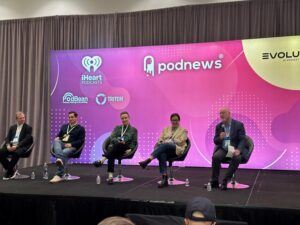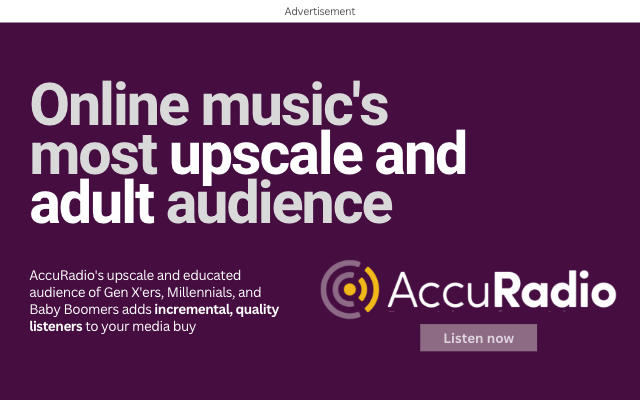
Steve Goldstein’s Amplifi Media works with media companies and podcasters in developing audio content strategies. Goldstein writes frequently at the Amplifi blog. Steve can be reached directly at 203-221-1400 or sjgoldstein-at-amplifimedia-dot-com.
Last week at Podcast Movement Evolutions, I assembled a great group of podcast leaders for our 9th “View from the Top” panel, including:
- Drew Marcus, a Senior Advisor at Guggenheim Securities
- Dan Granger, the CEO and Founder of podcast agency Oxford Road
- Jenna Weiss-Berman, who runs Audacy and Pineapple Media’s podcast initiatives
- Sarah van Mosel, an industry veteran back at SiriusXM as SVP of Podcast Strategy
 We covered a good amount of ground – everything from the state of the podcast business, ad markets, video, and AI. Here are some highlights from our conversation, edited for clarity and brevity.
We covered a good amount of ground – everything from the state of the podcast business, ad markets, video, and AI. Here are some highlights from our conversation, edited for clarity and brevity.
I started by asking Drew Marcus of Guggenheim Securities where we are as a business.
Drew Marcus: The future of media is streaming. The stock market is supposed to be an efficient predictive entity. In the past year, Spotify stock has doubled, iHeart stock has been cut in half, Netflix stock has doubled, and Warner/Discovery stock has approximately been cut in half. Media executives are obviously very cognizant of this, so they’re leaning into digital strategies, with podcasting being one of them. Podcast listenership is going up. Radio listenership is going down. In the past five years, time spent listening to radio is down about 25%.
It’s also vital for these companies to be profitable. When we were in a zero-interest rate environment, the path to profitability wasn’t as important. Now it’s very important. In the early days of podcasting, there was a land rush to get content. Some of the minimum guarantees and contracts were crazy and not profitable, but it gave people a foothold.
The industry is going through natural growing pains and is being more rational. If you look at revenue, the podcast industry crossed 2 billion. Last year, podcasting was bigger than the national spot business for commercial radio. This year, it’ll be bigger than the national spot business plus the network radio business. So, the industry is hitting critical mass.
Steve Goldstein: It was a challenging year for Audacy with bankruptcy, layoffs, and restructuring. When I first talked to Jenna Weiss Berman about joining the panel, the first thing she said to me was, “I’m very optimistic.”
Jenna Weiss-Berman: Yeah, it’s been a fun time! I am always optimistic, so I don’t know that anyone should trust me, but I’m feeling more bullish and positive about podcasting than I ever have. I think part of what Drew was saying is that we were running the business of podcasting not necessarily in the smartest way, because it was a brand-new industry. There were these huge minimum guarantees that we could never make back.
There was a lot of money being thrown at podcasting and not a whole lot of attention being paid to how to make it profitable. I get very excited by thinking about making things profitable and sustainable. We’re at a really good place — we’re seeing tons of new advertisers and content. We need to be making smart deals.
Steve Goldstein: Dan Granger runs Oxford Road, one of the top podcast agencies, and we know the ad markets were choppy last year.
Dan Granger: A lot of folks are having a bit of a hangover because of so much of the exuberance.
We are seeing big pivots. There is increasing pressure on efficiency and measurement, finding ROI, and proving that something happened because of the money spent. Put yourself in the advertiser’s shoes. There’s a lot more scrutiny. Sometimes, they say, “We can’t sign that big sexy package. We can’t make that large commitment to the famous person that’s just signed onto your network.”
There’s also a lot of buyer confusion about the latest advancements in programmatic, AI, brand safety, and suitability. Many people are feeling a sting today because of the iOS update, but things like that will keep happening. Clients don’t want to jump from the bottom to the first floor. We need to build staircases and ease them in a little bit more slowly.
Why is Amy Poehler doing a podcast? She’s been primetime on NBC. It’s because podcasting is the greatest canvas in media. That’s why she wants to be here. (note: Amy Poehler was interviewed by Jenna shortly before our session).
Steve Goldstein: Sarah van Mosel rejoined SiriusXM a few weeks ago. We discussed what’s different the second time around with a big push to move beyond satellite. This morning, I read that Warren Buffett has been buying a lot of SiriusXM stock. He must know Sarah is back on board.
Sarah van Mosel: It’s me, yes. Warren and I had a conversation!
I was a part of the Midroll team prior to the acquisition, and I was the Chief Revenue Officer. We went through the process of integrating cultures, teams, and processes.
I think the effort to put the app out there is twofold: One, to meet listeners with the content they love wherever they are, whether in their car or out in the world. Two, there are more data points that you can get from an app than you could necessarily get from a satellite environment. That data is crucial to understanding the behavior of our users and offering them more options, and optimizing our business based on real-time data so we can be where we need to be and plan the next phase of our business.
Steve Goldstein: Let’s talk about the push to YouTube. Jenna, you and I were in a session at Hot Pod in Brooklyn, where Kai Chuck from YouTube was on hand. There was a lot of consternation over podcasting and YouTube. Amplifi Media did a study with Coleman Insights at the last Podcast Movement about YouTube being the dominant search engine but not necessarily the dominant listening platform. Other studies from Signal Hill Insights and Sounds Profitable reinforce where we are in the YouTube era.
Jenna Weiss-Berman: That was a closed-door session where you saw me get a little heated at the YouTube rep. Sorry, Kai, if you’re not here, it’s because you probably don’t want to see me again. Half of me is basically okay, and saying YouTube is part of the future of podcasting and should probably accept this. The other half feels YouTube hasn’t yet really played ball in any real way with podcasters and doesn’t support dynamic ad insertions. So essentially, when we put something on YouTube, we can barely monetize it.
Also, I would say from the creative side I don’t want the magic and art and beauty of audio to be lost when we’re focused on video. A podcast is audio-first. We pay attention to what will make it work in audio, from the pacing to the editing. We don’t see a ton of listeners on YouTube, really nothing super meaningful yet. YouTube will have a big future in podcasting, but we do need them to play a little nicer with us. I may be overly honest, but that’s how I feel about it right now.
Steve Goldstein: Dan, are advertisers interested in video?
Dan Granger: They are. I think they’re largely interested because the whole is greater than the sum of the parts with return on ad spend. So, we welcome video where it makes sense. I would flag that there’s a lot of confusion in the marketplace because we’re increasingly servicing large brands that can be very siloed by channel. There can be a lot of confusion about whose job it is to greenlight an ad. Is it YouTube? Is it video? Is it audio podcasts? What is a podcast like? This gets overwhelming quick.
Steve Goldstein: I’ve written about disintermediation in my Thought Letter. TV is a primary example. A network like NBC doesn’t count on you watching a show on Thursday at 9. They have apps, streams, and YouTube channels to grab viewership on all types of platforms. Can we even be thinking that podcast producers can control how people consume podcasts?
Sarah van Mosel: When you think about all the places that a creator can decide to put their content, and you think about the expectations for the viewers on those platforms, TikTok is super casual and authentic. Instagram is sort of perfect and polished. YouTube’s a little bit neutral. We’ve got people in ball gowns and PJs – like whatever you want, whatever the content dictates. So, I would warn against letting the platforms lead the content.
Drew Marcus: The tech giants have a lot of resources. To put things in scale, the seven largest tech companies have net about $700 Billion in cash. The ten largest media companies have about $200 Billion in debt. The tech companies are the innovators. They are the disruptors with the pristine balance sheets and resources. When they put their mind to it, they can build without buying. YouTube TV is now the fourth largest “cable company.” I have no idea whether YouTube will have the same power in podcasting, but they have the resources to make it work.
Steve Goldstein: No panel would be complete without a discussion of AI.
Sarah van Mosel: When I was launching my company, AI gave me the inspiration to do it. How do you start a gaming company? You need expensive developers. I uploaded a show transcript and said, summarize the plot into five points, and now write me some code in Python for a very simple single user explorer game. And it spit out the code. I put it into a website that turned the code into an actual game. This took me five minutes to turn a transcript into a playable game. And I’m a dummy when it comes to engineering and stuff like that.
I think we all sort of thought long and hard during the writer’s strike about these kinds of issues. Are there processes that humans could be freed up from to focus on the things humans do best, which is create art, right?
Some folks are using AI to translate existing shows into other languages to have a larger reach. It’s a tool just like all the other technology we learned to adapt and integrate into our lives to free us up. I don’t hand wash my laundry, right? I don’t think my washing machine’s the devil. It’s freed me up to do other stuff with my life.
Dan Granger: Artificial is the opposite of authentic. We need to be in a business of authenticity, of real relationships. And when you try to take AI and machine learning and apply to brand safety sometimes it misses the intent. We work with a company called Seekr and they have a civility score which is one simple metric that says how many personal attacks are going on per hour in your show. Because that’s something you can actually measure.
Thank you again to our panelists — an impressive crew with valuable insights. This summer at Podcast Movement 2024 in Washington, we will have our 10th edition of View from the Top. See you there.

